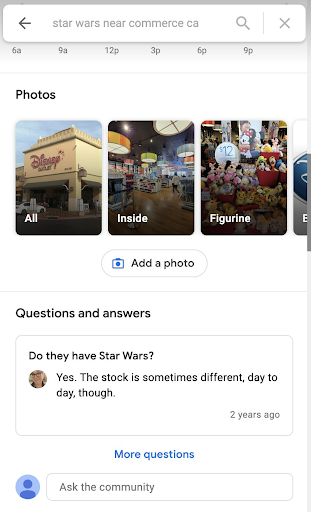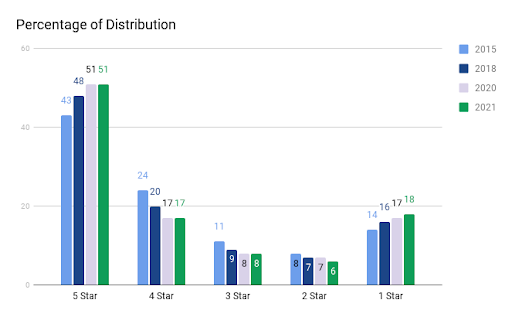What Are AI Agents? And Why Are They Critical to Local Marketing Success?
Local Memo: Food Delivery Outpaces Rides for Uber
In this week’s update, learn about the rise of Uber Eats; Google’s new calls API; the removal of appointment links from Google profiles; newly prominent Q&A excerpts in Maps; Meta’s recommendations to advertisers; and the history of review distribution on Yelp.
Food Delivery Outpaces Rides for Uber
In a sign of changing times, Uber has reported that Uber Eats was the largest source of revenue for the company in 2021, outpacing revenue for Uber’s foundational ridesharing service for the first time in the company’s history. Though Uber’s ridership has grown every quarter since summer 2020, the volume of rides fulfilled by the company has yet to return to pre-pandemic levels. Meanwhile, revenue from Uber Eats has grown from $1.9 billion in 2019 to $8 billion in 2021, making Uber Eats the highest revenue, and most broadly available, delivery service globally. (DoorDash is the dominant service in the U.S., with 58% market share.) Uber plans to double down on its success in delivery by expanding grocery delivery services in North America and Europe in 2022.
Google Launches Calls API for Business Profiles
Google has launched a new API to help businesses track phone calls generated from their Google Business Profiles. The initial version of the API has the somewhat redundant (and outmoded) name the My Business Business Calls API. It’s unclear why Google is using the older “My Business” naming convention here, while having switched to Google Business Profiles in most other places.
Regardless, the new service represents a partial API launch of the Call History feature which has been live in beta in the Profile Manager dashboard for several months. The dashboard version offers a table of recent phone calls, identifying the inbound phone number and whether the call was answered or missed. In the API version, programmers can enable or disable Call History for select locations and can retrieve call counts for answered and missed calls, but not the numbers themselves.
The new API joins a growing list of single-purpose APIs, some of which contain new functionality and some of which replicate older features in the original Google My Business API. Google will eventually replace the legacy API, once all needed functionality has been replicated with single-purpose APIs.
Appointment Link Removed from GBP Manager
Several users have reported, and SOCi has confirmed as well, that the appointment booking link has disappeared from the edit view of most if not all Google Business Profiles. It appears that most appointment links previously set by business owners are still appearing in public profiles, but they can no longer be added or edited. Reports also state that the API feature for setting appointment links can still be utilized and does not return an error, but also does not successfully show an appointment URL in the public listing. Finally, according to one user, booking links previously published in Google Posts using the “Book Now” button have been replaced with links to the company’s main website. No word yet from Google on whether the change is intended or the result of a bug.
The appointment link was a popular feature, so it’s odd that Google would remove it without notice or explanation. Hopefully we’ll have more information soon. Usually, when Google removes a feature, it’s due to lack of adoption, as was the case with the “Follow” button and accompanying welcome offer, first launched in 2018. The “Follow” button was supposed to let Google Maps users follow a business and see its updates more prominently, but apparently not many users did this. In contrast to its silence over appointment links, Google issued an official notice the other day that the Follow button would be deprecated.
Newly Prominent Questions and Question Prompts in Maps
Allie Margeson from Whitespark pointed out on Twitter that Google has begun displaying a prominent excerpt from Questions and Answers in profiles on the desktop version of Google Maps. The new Q&A excerpt appears to be rolling out slowly to all users. Though some users were not able to replicate it, I was able to see the change right away in every listing I examined. SOCi’s Michael Snow and I were able to trigger Q&A excerpts for generic searches like “Mexican restaurant near me” as well as searches for a specific business. Michael also found that relevant questions are highlighted when searching for something more specific, as illustrated in the screenshot. If a business has no Q&A content, Google prompts the user to ask a question, saying, “Questions are often answered by the community within 20 minutes.”

Product-specific content in new Q&A excerpt feature in Maps for desktop
Meta Offers Recommendations for Dealing with Apple Update
Facebook continues to be challenged by Apple’s AppTrackingTransparency (ATT) update, launched last April as part of iOS 14.5. The update prompts Apple users to opt in to tracking their activity within apps; estimates suggest that approximately 62% of iPhone users are choosing to block Facebook from gathering their data. As a result, Facebook cannot target those users with ads based on their specific interests, nor can the company accurately report on conversions when opted-out users make purchases by clicking on ads in the Facebook platform. Facebook parent company Meta, whose Instagram platform has also seen its ad effectiveness significantly impacted by ATT, projects a loss of $10 billion in ad revenue in 2022 due to the changes. Meta has recently published some new recommendations for advertisers, designed to help mitigate the impact of underreported conversions and improve performance of ad campaigns. The recommendations include utilizing Facebook’s Conversions API; verifying with Facebook the domains you’re driving traffic to; using Facebook’s machine learning tools to automatically find relevant audiences; and running ads in multiple placements across Facebook and Instagram.
Yelp One-Star and Five-Star Reviews Are Increasing
A new post from Joy Hawkins compares several of Yelp’s annual reports that detail the distribution of ratings on the platform. According to her findings, the volume of five-star and one-star reviews has grown in recent years while the volume of four-star, three-star, and two-star reviews has declined. The trends would suggest increasing polarization in reviews, though the overall percentages tell a slightly different story, with 68% of reviews in 2021 coming in at four or five stars and 32% at three stars or below.
As Hawkins notes, average ratings on Yelp tend to be lower for the same business than on other platforms like Google and Trip Advisor. She suggests a few reasons for this: Yelp likely removes many fake positive reviews through its filtering software, and studies show that Yelp’s position against review solicitation can lead to a lower overall volume of positive reviews.

Star ratings on Yelp 2015-2021, courtesy LocalU




